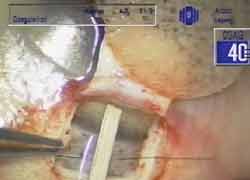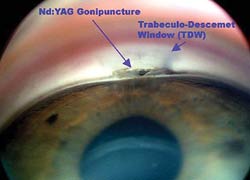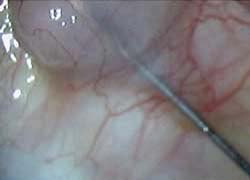Mitomycin-C can improve bleb needling after deep sclerectomy, surgeon says
Implants such as STAAR Surgical’s AquaFlow can help maintain the intrascleral space should fibrosis develop after deep sclerectomy.
![ESCRS Meeting [logo]](/~/media/images/news/print/ocular-surgery-news-europe-asia-edition/2004/01_january/osnatescrs_130_94_6806.gif) MUNICH, Germany — Adjunctive use of an antimetabolite can improve the effectiveness of bleb needling, reducing the potential need for re-treatment, according to a surgeon speaking here.
MUNICH, Germany — Adjunctive use of an antimetabolite can improve the effectiveness of bleb needling, reducing the potential need for re-treatment, according to a surgeon speaking here.
Ike K. Ahmed, MD, FRCSC, a surgeon in Mississauga, Ontario, discussed the role of goniopuncture and bleb needling during the European Society of Cataract and Refractive Surgeons (ESCRS) annual meeting.
He said bleb needling is primarily indicated for postoperative elevations in intraocular pressure (IOP) after deep sclerectomy, when episcleral fibrosis is believed to be the main cause.
“If you think about it, the issue at hand is fibroblastic proliferation and cellular proliferation,” he told Ocular Surgery News in an interview.
“When you needle, you basically break the adhesions that formed around the scleral flap, which are impeding the flow of fluid into the subconjunctival space. The problem is, you cut through the adhesions, but those cells are not in remission. Those cells are going to proliferate, possibly at a more vigorous rate because of what was done,” he said.
The addition of an antimetabolite can help to inhibit that response, he said.
Bleb needling
According to Dr. Ahmed, the main difference between standard penetrating trabeculectomy and nonpenetrating deep sclerectomy is that deep sclerectomy creates two main points of potential resistance — the trabecular-Descemet’s window and the episclera.
“It is important to distinguish between both of those when dealing with someone who has had a nonpenetrating surgery and develops elevated IOP,” he said.
Dr. Ahmed said surgeons basically have three choices for deep sclerectomy patients who develop elevations in IOP — laser goniopuncture, bleb needling or a return to glaucoma medications.
|
|
|
|
|
|
He said he prefers to avoid a return to glaucoma medications because these patients have already failed to respond to medical therapy.
Also, glaucoma medications contain preservatives that have been shown to be toxic to the conjunctiva. Because these patients have undergone surgery that is dependent on the health of the conjunctiva, using medications that could deteriorate its health further could lead to additional fibrosis and lack of control.
He said Nd:YAG laser goniopuncture would be preferred if the point of resistance is at the trabecular-Descemet’s window.
However, if the bleb appears to be growing progressively thicker and scarred, that typically indicates bleb fibrosis rather than trabecular-Descemet’s window fibrosis, and needling would be preferred, he said.
Intraocular penetration
Dr. Ahmed noted that there are some concerns with the use of antimetabolites, particularly intraocular penetration.
When injecting the antimetabolite near the bleb site, he said, it is important to inject it fairly posterior and away from the bleb rather than into the bleb. It is also important to wait about 20 minutes and allow the drug to absorb before performing the needling. He also combines the injection with lidocaine with epinephrine for analgesia.
“Generally speaking, the vast majority [of patients] in my practice do receive needling. I think it is safe,” he said.
Dr. Ahmed noted that he prefers to use mitomycin-C (MMC) for his needling procedures because it is a more potent inhibitor of cell cycles and growth than 5-fluorouracil (5-FU).
He said 5-FU is an important wound modulator, but it is often not powerful enough because it acts primarily against cells that are in an active growth cycle.
In contrast, at usual doses, MMC is more potent because it affects both cells that are actively growing and those that are dormant.
“In my experience, patients require multiple 5-FU injections, multiple needling, and they develop a higher rate of corneal toxicity,” he said. “With MMC, the average needling is once. It’s a one-time deal for that immediate issue.” He noted that it does depend on patient risk factors, bleb appearance and previous attempts at needling.
“Eventually, there will be a subset of patients that are going to have long-term cellular growth and proliferation that will impede the flow of fluid. We continuously heal our wounds. … But we basically hope to stun the cells enough that we have a long-lasting effect,” he said.
During ESCRS, Dr. Ahmed presented the results of a retrospective case review he conducted. The study involved 21 eyes of 19 consecutive deep sclerectomy patients who required postop bleb needling for elevated IOP.
According to the study, all patients had undergone an initial Nd:YAG goniopuncture. For the needling procedure, eight eyes were treated with adjunctive 5-FU and 13 eyes with adjunctive MMC. Follow-up averaged 13.3 months.
According to the study, patients treated with MMC required statistically significantly fewer subsequent bleb needlings compared with patients treated with 5-FU. MMC patients required 1.1 ± 0.3 re-treatments compared with 2.8 ± 0.8 for patients treated with 5-FU.
Dr. Ahmed said statistically significantly more MMC patients had IOPs lower than 18 mm Hg without medications, 77% compared with 50% of the 5-FU group.
Advantage to deep sclerectomy
When performing a deep sclerectomy, Dr. Ahmed said he also uses the AquaFlow (STAAR Surgical) collagen implant for the majority of his procedures.
| Antimetabolite comparison: 5-FU vs. MMC | |
Source: Ahmed IK. |
He said that in his experience the device has helped to improve the effectiveness of such procedures because it helps maintain the intrascleral space.
However, he noted that any similar device may also be beneficial, such as the SKGEL sodium hyaluronate implant (Corneal).
“I have most of my experience with the AquaFlow. That is my preference,” he said. “But [one could use] any kind of implant that will provide for maintenance of that space.”
Compared with trabeculectomy, he said the AquaFlow device offers the advantage of creating an intrascleral lake that is often maintained when a bleb does develop fibrosis. In such cases, when bleb needling is required, the needle can simply be guided into that lake, he said.
“It is important to understand that when episcleral fibrosis occurs, it typically is around the scleral flap. That basically results in fluid being trapped under that flap,” he said.
“If one wants to get into the scleral flap, just raise it slightly. All it takes is one or two punctures, and that will re-establish flow. If you already have a space to get into, it is much easier compared to creating a whole new space because of fusion of flaps,” he said, explaining that in standard trabeculectomies the scleral flaps often become fused to the dissection bed.
“With a deep sclerectomy with the AquaFlow, the intrascleral lake is preserved in most cases despite the fact that there may be extensive episcleral fibrosis,” he said.
For Your Information:
- Ike K. Ahmed, MD, FRCSC, can be reached at Credit Valley EyeCare, 3200 Erin Mills Parkway, Unit 1, Mississauga, Ontario L5L 1W8, Canada; (905) 820-6789; fax: (905) 820-0111; e-mail: ike.ahmed@utoronto.ca. Dr. Ahmed has no financial interest in the products mentioned in this article.
- STAAR Surgical, manufacturer of the AquaFlow, can be reached at 1911 Walker Ave., Monrovia, CA 91016; (626) 303-7902; fax: (626) 358-9187.




